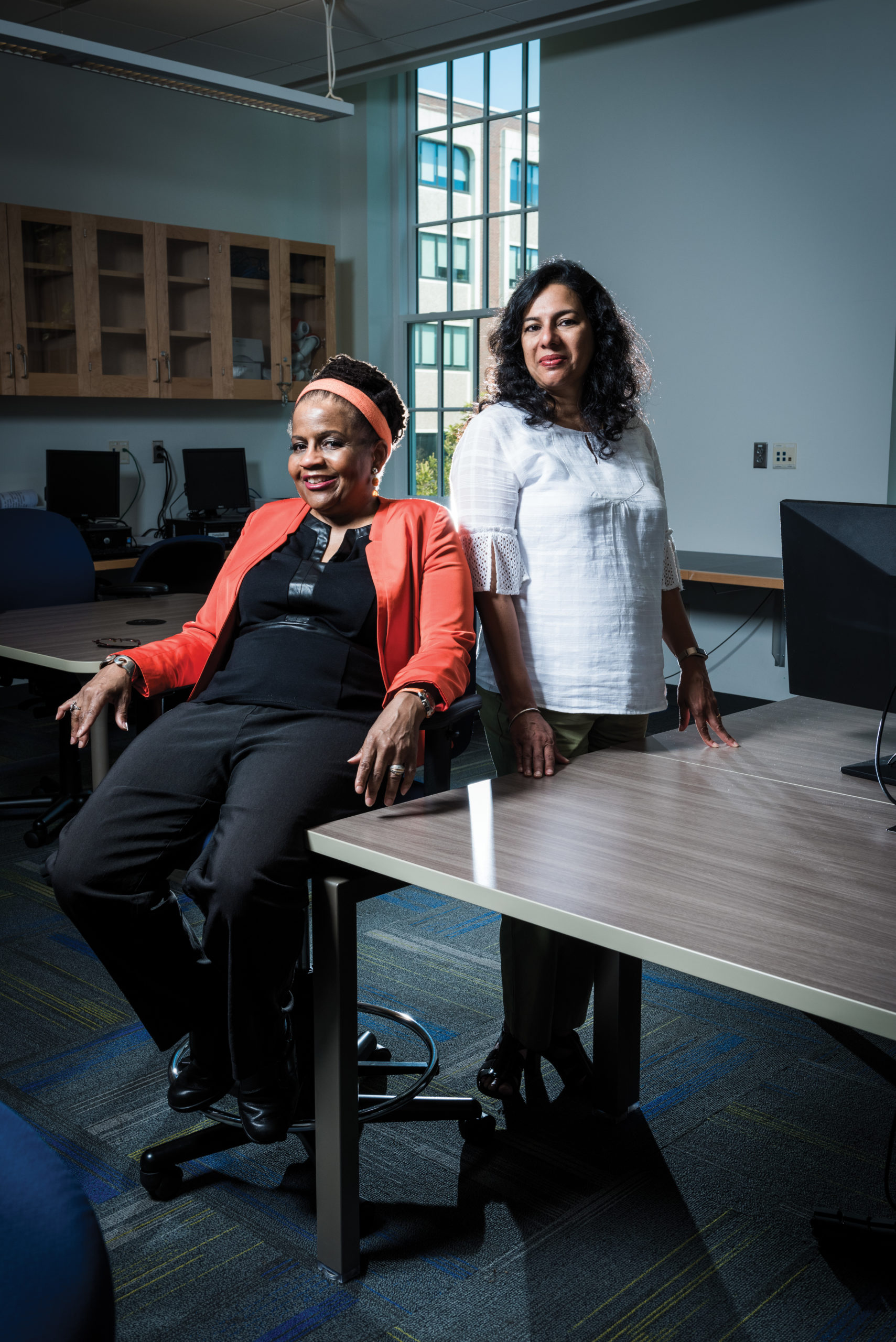Better together
Two professors with different backgrounds set the standard for real-world collaborative education.

TCNJ Journalism Professor Kim Pearson (orange jacket) and TCNJ Computer Science professor Monisha Pulimood (white top).
In fall 2020, Maya Hendl ’23 found herself in an unfamiliar situation: in a class that required criminology students like herself to collaborate on a project with computer science students.
Their task: create a website for a community partner, the Greater Trenton Chapter of the Campaign to End the New Jim Crow, that would make local data about issues such as bail reform and felon disenfranchisement more widely accessible. But Hendl, who majors in both criminology and women, gender, and sexuality studies, says things got off to a slow start, and not because the students were forced by the pandemic to meet online. More awkwardly, the two sets of students sometimes simply could not understand each other.
At one point, a student from the computer science side told her, “Whenever you guys tell us about criminology stuff, it’s like you’re speaking a different language,” Hendl says. “And I said, ‘That’s exactly how I feel when you guys talk about coding.’”
Spanning that disconnect, however, was pretty much why the two groups had been thrown together in the first place — and they had computer science professor Monisha Pulimood and journalism professor Kim Pearson to thank. When the two instructors began intermingling students from disparate learning tracks more than a decade ago, “one of our goals was to pair students from disciplines that are so different that they would have a hard time figuring out what they can do together,” says Pulimood.
The program, known as Collaborating Across Boundaries, might be traced to 1990, when Pearson arrived at TCNJ to teach journalism after a career that included a seven-year stretch at Bell Labs, widely considered a model of idea cross-pollination. “I immediately started running my classes as if they were virtual businesses, and looking for collaborators outside of my department,” she says.
Pearson’s first collaborative effort brought together students of communications, art, and engineering to create “a very fancy lamp,” as well as plans for producing and marketing it. In the end, “there were some manufacturing glitches, and there was a quality-control problem,” she says, but even those “mimicked what would happen in the real world.”
CAB formally began taking shape around 2009, when Pearson invited Pulimood and her students to work on a National Science Foundation–funded writing and computing project with Fisher Middle School in Ewing Township. Partnering with an off-campus organization to advance solutions to social issues created a template that helps define the program.
Thanks to NSF funding, CAB is expected to have 13 collaborations running simultaneously this year, says Pulimood. Recent pairings have had students helping Habitat for Humanity decide whether to accept donations of real estate that could require huge, hidden expenses for environmental cleanups and assisting the Trenton Public Library to make a large cache of oral histories more accessible.
The project is powered by the idea that when students are immersed in complex, real-world problems, and working with people of differing perspectives, “they’re more engaged in their own learning, and we get better solutions, and they learn something from the other people in the group as well,” Pulimood says.
It’s working, says John DeGood, a software engineer with 40 years of private-sector experience who immediately embraced the interdisciplinary approach when he began teaching computer science at TCNJ four years ago. His students have learned from working with others who had a much better perspective on human factors and audience engagement, areas his students were not as strong in. “I think that will assist them when they go beyond college and out into the working world,” he says.
Criminology professor Maggie Leigey, whose class worked on the Campaign to End the New Jim Crow website, says her students, including Hendl, “certainly benefited” from the approach. Combining disciplines not only gives them “a way to see the work that other students across campus do,” she says, but it’s also “harnessing both fields’ areas of expertise to produce something I know my students could not have produced on their own.”
After the bumpy start, Hendl’s participation in the collaboration left her wanting more. She found that it exposed her to new points of view, pressed her to be clearer in articulating her ideas, and “made me, for lack of a better word, more of a grownup,” she says.
Photo: Peter Murphy
Posted on October 8, 2021

